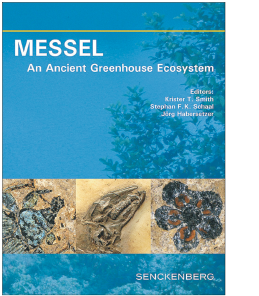

 World
in the shale
World
in the shale
Krister T. Smith, Stephan F.K. Schaal, and Jörg Habersetzer (Eds.) 2018. Messel—An Ancient Greenhouse Ecosystem. 355 pp. Senckenberg Gesellschaft für Naturforschung. ISBN 978-3-510-61411-0 (hardcover). Price 54.90 €. [Also available in German]
Rudolph Ludwig’s description of a fossil crocodyliform (now known as Diplocynodon darwini) from the Messel Pit in 1877 represented more than just a footnote to the history of science. It also started the still ongoing research on this exceptional Eocene locality recognized in 1995 as a UNESCO World Heritage Site. Messel is an important window on the middle Eocene (ca. 47.5 Ma) in Europe, also due to the astounding preservation of its fossils in the oil shale, sometimes with their coloration, feathers, foot scales, fur cover, internal organs, and even stomach contents.
The book is the result of a collaborative effort of 28 acclaimed scientists working in Germany, the USA, Argentina, Ecuador, Great Britain, Slovakia, and Switzerland. Half of researchers are affiliated with the Senckenberg Research Institute, which has been central to the Messel research since decades.
After three forewords and a brief preface, the book is divided into 13 chapters. First five chapters are shorter and more general in scope, and deal with the mining history, the geological setting of the Messel Maar, paleoclimate, preservation and taphonomy of vertebrate skeletons, and finally with research methods and techniques. Altogether, they are of great value for undergraduate students or even interested non-professionals, although the text may be in rare instances too technical for the latter. The remaining chapters deal with fossil plants, insects and other invertebrates, ray-finned fishes, amphibians, reptiles, birds (of which approximately 70 species have been found in Messel, which makes them the most speciose vertebrate group there), mammals, and a brief final chapter concerns the Messel ecosystem. Although most of the book is devoted to vertebrates, it is invertebrates, in particular insects, which hide probably hundreds of species waiting to be discovered and named. Chapter 7, aptly entitled “Jewels in the Oil Shale” gives us a glimpse of this dead and buried diverse world. The exhaustive, carefully prepared bibliography, list of authors and index sections complement the book. Equally important are nearly 400 illustrations throughout the text, some of them among the most exquisite photographs of fossils I ever saw.
As a vertebrate paleontologist working mainly on mammals, I am particularly indebted for the longest Chapter 12, which is further subdivided into nine parts, concerning marsupials, early placentals, lipotyphlans, primates, bats, rodents, carnivorans and pangolins, artiodactyls, and perissodactyls.
Among four archaic placentals, namely Buxolestes (a pantolestid), Kopidodon (a paroxyclaenid), Heterohyus (an apatemyid), and Leptictidium, the last is of particular interest. This long-snouted mammal belongs to the Pseudorhyncocyonidae and is known from nearly 20 complete skeletons found in Messel, attributed to three species; other middle Eocene localitites yielded only fragmentary remains. Leptictidium had a tail with over 40 vertebrae, one of the longest tails among mammals, and very long hind legs; it is portrayed as an obligate biped, probably jumping on the forest floor. Generally Leptictidium anatomy combines characters typical of early placentals (e.g., in the cranium and dentition) with specialized locomotor adaptations, which obscures the phylogenetic position of the family within, most probably, the Laurasiatheria.
Arguably, the most famous mammal fossil from Messel is an adapiform primate Darwinius masillae, nicknamed “Ida” because the nearly complete (preserved with fur) specimen belongs to an immature female. Apart from the staggering sum of about $750,000 paid by the Natural History Museum of the University of Oslo (Norway) for a counterslab which came to market in 2006, Darwinius was claimed to be the “missing link” in human evolution, which implies that adapiforms are ancestral to haplorhines (tarsiers and anthropoids). The debate ensued and now most cladistic analyses (e.g., Seiffert et al. 2009; Ni et al. 2013) suggest that adapiforms are rather sister taxon to crown strepsirhines (lemurs and lorises).
To sum up, much has been written about the world-renowned Lake Messel site and you may wonder if there is a place on your shelf for another book on the topic. My answer is a definite “yes”. Even if you are not interested in the Messel insects (beautiful specimens frequently preserved with structural colors), or turtles caught in flagrante (p. 157), the chapters offer an excellent source of information on the evolution of life in this unique Eocene ecosystem. Overall I recommend this volume not only to specialists and students, but to a wider audience interested in fossils and evolution.
References
Seiffert, E.R., Perry, J.M.G., Simons, E.L., and Boyer, D.M. 2009. Convergent evolution of anthropoid-like adaptations in Eocene adapiform primates. Nature 461 (7267): 1118–1121. Crossref
Ni, X., Gebo, D.L., Dagosto, M., Meng, J., Tafforeau, P., Flynn, J.J., and Beard, K.C. 2013. The oldest known primate skeleton and early haplorhine evolution. Nature 498 (7452): 60–64. Crossref
Łucja Fostowicz-Frelik [lfost@twarda.pan.pl], Institute of Paleobiology, Polish Academy of Sciences, ul. Twarda 51/55, PL 00-818 Warsaw, Poland.
Acta Palaeontol. Pol. 64 (1): 156, 2019
http://doi.org/10.4202/app.00611.2019